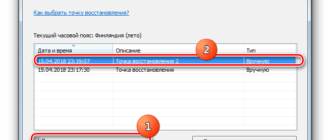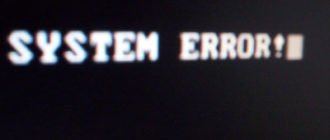
Как бы грустно не звучало, но ошибки – это неотъемлемая часть рабочего процесса операционной системы Windows. У кого-то из пользователей они возникают чаще, у кого-то реже. Избавиться от них полностью нельзя, но к счастью, многие из них можно исправить. В данной статье мы расскажем вам о том, как решить проблему с сообщением «WHEA UNCORRECTABLE ERROR» в Виндовс 10.
Методы исправления ошибки «WHEA UNCORRECTABLE ERROR»
В первую очередь нужно отметить, что упомянутая ошибка может быть вызвана как программным сбоем, так и физической неисправностью оборудования. Именно поэтому устранить ее с первого раза и наверняка удается не всегда. На практике она выглядит как обычный BSOD («Синий экран смерти» или «Blue screen of death»).

Мы предложим несколько вариантов решения проблемы, которые необходимо попробовать в первую очередь.
Способ 1: «Командная строка»
Прежде чем приступить к поиску физических неисправностей оборудования, мы настоятельно рекомендуем провести программную проверку жесткого диска и целостности системных файлов. Обе эти операции выполняются с помощью встроенной системной утилиты «Командная строка».





Способ 2: Проверка обновлений
Разработчики Windows 10 регулярно выпускают обновления, и нередко они как влекут за собой ошибки, так и позволяют от них избавиться. Для решения нашей проблемы сделайте следующее:



Способ 3: Обновление драйверов
Нередко ошибка «WHEA UNCORRECTABLE ERROR» возникает из-за проблем с драйверами или их взаимодействия с операционной системой. Именно поэтому можно попробовать обновить драйвера всех устройств. Для этих целей как нельзя лучше подойдет специализированный софт. О лучших приложениях такого рода мы рассказывали в отдельной статье. Рекомендуем перейти по ссылке, ознакомиться с материалом и выбрать для себя любую программу.

Способ 4: Проверка ОЗУ
Данный способ подразумевает под собой проверку оперативной памяти на наличие физической неисправности. Для этих целей есть несколько специализированных программ и системных утилит. Они покажут, есть ли проблемы с ОЗУ. Если таковые будут обнаружены, стоит попробовать заменить поврежденную планку памяти и проверить, появится ли ошибка «WHEA UNCORRECTABLE ERROR» вновь. О приложениях для тестов и самом процессе проверки мы ранее писали.

Способ 5: Проверка температур
При возникновении ошибки «WHEA UNCORRECTABLE ERROR» крайне желательно проверить температуру комплектующих компьютера. В некоторых случаях причина рассматриваемой проблемы заключается в перегреве, особенно если от такового страдает видеокарта и/или процессор.

В статье по ссылке выше вы найдете инструкцию, как узнать максимально допустимые значения температур для разных видов устройств. Если вы выявите, что они превышены или же находятся на грани допустимых, стоит позаботиться о должном охлаждении и замене термопасты (если речь о ЦПУ). Кроме того, в обязательном порядке избавьтесь от оверклокинга, если вы делали разгон характеристик оборудования.
Способ 6: «Просмотр событий»
В каждой редакции и сборке Windows 10 есть встроенная функция логирования. Она представлена в виде приложения «Просмотр событий», в котором отображаются все ошибки и уведомления о работе операционной системы, взаимодействии устройств и т. д. Данный инструмент позволяет более точно определить источник появления ошибки «WHEA UNCORRECTABLE ERROR». Для этого просто запустите приложение после возникновения проблемы и найдите подробную информацию о случившемся. О том, как именно это сделать, вы можете узнать из статьи по ссылке ниже. Далее, узнав описание проблемы, воспользуйтесь поиском на главной странице нашего сайта и найдите материал по ее решению.
Таким образом, вы узнали об основных способах исправления ошибки «WHEA UNCORRECTABLE ERROR». Помните, что причина проблемы может крыться гораздо глубже, например, в недостаточном вольтаже на процессоре. Самостоятельно его изменять не рекомендуем, дабы не навредить «железу» — в таких случаях лучше обращаться к специалистам.
Мы рады, что смогли помочь Вам в решении проблемы.
Помимо этой статьи, на сайте еще 11808 инструкций.
Добавьте сайт Lumpics. ru в закладки (CTRL+D) и мы точно еще пригодимся вам.
Отблагодарите автора, поделитесь статьей в социальных сетях.
Опишите, что у вас не получилось. Наши специалисты постараются ответить максимально быстро.
microsoft windows whea logger

Processor ID Valid: Yes
Processor ID: 0x0
Bank Number: 3
Transaction Type: Generic
Processor Participation: N/A
Request Type: Instruction Fetch
Memory/Io: N/A
Memory Hierarchy Level: Level 2
Timeout: N/A
From a newsgroup post, for an ASUS motherboard with an AMD CPU: «After three weeks of back and forth emails with MS tech support, here is the final answer that I got from them. Admittedly, my motherboard is slightly older but it worked great with XP and I’ve seen plenty of other people with much more recent AMD-based motherboards complaining about the same problem.
My hardare: ASUS a7n8x-e deluxe (nforce2 chipset), AMD Athlon xp 3200+, 1 GB Corsair (two dimms dual channel).
Email from MS tech support:
«I understand we have installed the latest BIOS update and AMD process update though they still too old. Since the current CPU is AMD Socket A and the Motherboard is ASUS Nvidia Nforce2 A7N8X-E, I checked the related information on their website. I am sorry to tell you that Nvidia claimed that nForce2 chipset has been discontinued as of date, since the product has reached the end of life stage. This is the reason they are unable to provide drivers with respect to Windows Vista operating system.
So these original BIOS and drivers may caused some conflict issue with Vista SP1. I also hope you could understand that there is little thing we can do on the system side to update these hardware BIOS and drivers. It is why you may received some warning prompt. I also submitted this information to our product group. They will check if there is available to release some fix tool to cover it, but as I said, since it is related to hardware, it is hardly to do something only on system side.»
From a newsgroup post, by Microsoft support engineer:
«AMD provides a tool called MCAT (Machine Check Exception Analysis Tool). You can find it on the AMD site in the downloads/processor utilities section. Choose the version appropriate to your processor. It installs a command line utility. To use it, execute mcat on the command line. There are several ways to use it. Execute mcat /? to see the possible options. Hopefully it can shed some light on the source of your problems.
Modern processors such as yours support advanced self-diagnostic capabilities, such that they analyze their own behavior and are capable of recognizing conditions that «can’t happen». When one of these not-possible conditions occur, the CPU raises a «machine check exception». Windows is simply retrieving the information provided by the processor and recording it in the event log.
You mention on this thread that you’ve tried many different processors. That would be my first recommendation. This eliminates the processor as a potential source of the problem. Several other possible causes still remain.
— Poor voltage regulation (i. e. power supply problem, voltage regulator malfunction, capacitor degradation)
— Damage due to power spikes
— Static damage to the motherboard
— Incorrect processor voltage setting in the BIOS (too low or too high)
— Overclocking
— Permanent motherboard or power supply damage caused by prior overclocking
— Excessive temperature caused by insufficient airflow (possibly caused by fan failure or blockage of air inlet/outlet)
— Improper BIOS initialization (the BIOS configuring the motherboard or CPU incorrectly)
— Installation of a processor that is too much for your motherboard to handle (excessive power requirement, incompatibility)
— Defective hardware that may be drawing excessive power or otherwise disrupting proper voltage regulation
The TLB is a part of the processor that manages translation of virtual addresses to physical addresses (to implement advanced memory management required for a multitasking operating system). The processor uses «page tables» to map virtual addresses to physical addresses. The TLB caches information from the page tables so it won’t have to keep looking up this information. The machine check exception in your post shows that, while the processor was attempting to fetch instructions to be executed, it detected invalid information in the TLB. This can lead to major software errors, so it raises a machine check exception. If windows doesn’t crash, the processor may have detected a benign error, but still an error worth reporting since it «can’t happen». It is highly unlikely that this sort of error could be caused by software (i. e. Windows), since the operation of the TLB is entirely automatic and managed by the processor itself.
Machine check exceptions are almost always caused by a hardware problem.»
I keep getting the following error message:
A corrected hardware error has occurred.
Component: PCI Express Root Port Error
Source: Advanced Error Reporting (PCI Express)
Vendor ID:Device ID: 0x8086:0xA115
Class Code: 0x30400
The details view of this entry contains further information.
HP Pavilion Gaming 15 — ak000nh
It always happens after system start and I got thousands of entries.
As I know I’m using the latest BIOS version F.71 which is not available on the download section anymore, neither this nor newer version.
I’m using the latest drivers installed by HP Assistant, and I tried to update all of them induvidualy too.
I also tried to reinstall the system and reset the BIOS to defaults including security settings. There was no effect I’m getting the message continuosly.
Is there any solution? Is there any update that can help? I saw a few same post here with same models, if this a known issue I would like to know the exact way to solve this issue.
WHEA-Logger flood — Event ID 17
01-01-2016 01:16 PM — edited 01-01-2016 01:19 PM
Its a hardware issue, software or drivers may not fix it, is it under Warranty?
You can try reinstalling all the chipset drives found at link below.
WHEA-Logger flood — Event ID 17
Installing drivers from there or drivers from other source does not change anything, however using drivers from different source the error is less frequent and does not continue to flood after windows has been loaded all of the drivers, strange.
The number of warnings decreased from thousands to hunders but I don’t know what causing this. It seems somehow connecting to network related drivers and services.
WHEA-Logger flood — Event ID 17
You can fix it by updating your Intel drivers in Devices manager.
right Click on every Intel entry in system and click on update driver and find one online.
It will download & update your drivers, reboot and then the event 17 flood will stop. Windows 10 always compare versions of every single drivers and always install the newest. Otherwise it does not install a driver.
There is a wider issue behind that. Now with windows 10, all driver updates should be automatically done by Windows 10 and windows update will download in the background the best drivers.
Do that for Nvidia drivers and you may be surprised that microsoft possess a newer driver compared to what was provided by Nvidia drivers installation.
In the property for every driver, look at the Event tab and you will see what & when drivers has been removed, installed. It is very useful.
I switched off the auto installation of HP support assistant. I have the feeling that HP support assistant blocks the automatic drivers update from windows 10. I don’t know whether i should not uninstall it completely and let windows 10 deal with all drivers. On the other hand HP softwares wil not be updated anymore.
Microsoft Certified Solutions Expert. (MCSE).
WHEA-Logger flood — Event ID 17
Mainly I tried every possible driver what I found, it seems I have this problem after latest BIOS update. I can’t find any earlier bios to roll back.
As I noticed I have this issue even if I try to run live Ubuntu and my SSD speed is recognized as SATA 2 with intel drivers. Strange because if I use Standard windows drivers, the speed is normal SATA 3.
WHEA-Logger flood — Event ID 17
I have HP Pavilion 15 Gaming ak001nu P5Q18EA
Under Windows 10 (64bit) i have about 500 messages pers second.
This causes about 300Kb/s constant traffic on the disk.
The problem comes from the PCI that holds the WIFI module (d evice ID: 0x8086:0xA115).
If i disable this PCI from device manager the error stop appearing.
I also tried every driver I found with no success.
Now the big problem is when I download something. The error rate
jumps alot. For something like 1GB of size downloaded on my HDD
I have 2GB of traffic from errors on my SSD.
Under Windows 7 (64 bit) the error still exists, but disable/enable
on the PCI causes it to stop completely.
WHEA-Logger flood — Event ID 17
Can you tell me what BIOS version do you use? I have a bad feeling. it is a BIOS issue, but of course I’m not sure.
WHEA-Logger flood — Event ID 17
My BIOS version is F.54
WHEA-Logger flood — Event ID 17
I don’t have idea just requesting the latest bios for our models.
By the way I have installed this driver and the error rate is now around 1-2 hundred on each restart. If I shut down and start my laptop I can’t find any Event ID 17 entry in Event Viewer, I know that is not a solution and I want a solution also.
WHEA-Logger flood — Event ID 17
I have the same errors.
HP ProBook 450 G3 running Windows 7 Pro,
Log Name: System
Source: Microsoft-Windows-WHEA-Logger
Date: 1/19/2016 7:56:24 PM
Event ID: 17
Task Category: None
Level: Warning
Keywords:
User: LOCAL SERVICE
Computer: HP-ProBook
Description:
A corrected hardware error has occurred.
Component: PCI Express Root Port
Error Source: Advanced Error Reporting (PCI Express)
Bus:Device:Function: 0x0:0x1c:0x5
Vendor ID:Device ID: 0x8086:0x9d15
Class Code: 0x30400
17
0
3
0
0
0x8000000000000000
0xdf
4
0x101
0x10
0x407
0x0
0x1c
0x5
0x0
0x0
0x0
0x8086
0x9d15
0x30400
0x0
0x0
0x0
0x0
0x1
00000000000000000000000000000000
672
435045521002FFFFFFFF02000200000002000000A002000017380100140110140000000000000000000000000000000000000000000000000000000000000000BDC407CF89B7184EB3C41F732CB571311FC093CF161AFC4DB8BC9C4DAF67C10497BE44B31F53D10100000000000000000000000000000000000000000000000010010000D0000000010200000100000054E995D9C1BB0F43AD91B44DCB3C6F3500000000000000000000000000000000020000000000000000000000000000000000000000000000E0010000C00000000102000000000000ADCC7698B447DB4BB65E16F193C4F3DB00000000000000000000000000000000030000000000000000000000000000000000000000000000DF00000000000000040000000101000010000704000000008680159D000403051C00000000000000000000000000000000000000108042010180000007001100124C72064200117000B22C0000004001080000000000000000000000000000000000000000000000000000000000000001000114000000000000000011000600010000000000000000000000000000000000000000000000000000000000000000000000000000000000000000000000000000000000000000000000000000000000000000000000000000000000000043010000000000000002000000000000E306040000000000000000000000000000000000000000000000000000000000000000000000000000000000000000000000000000000000000000000000000000000000000000000000000000000000000000000000000000000000000000000000000000000000000000000000000000000000000000000000000000000000000000000000000000000000000000000000000000000000000000000000000000000000000000000000000000000000
https://lumpics. ru/how-fix-whea-uncorrectable-error-in-windows-10/
https://window-10.ru/microsoft-windows-whea-logger/


